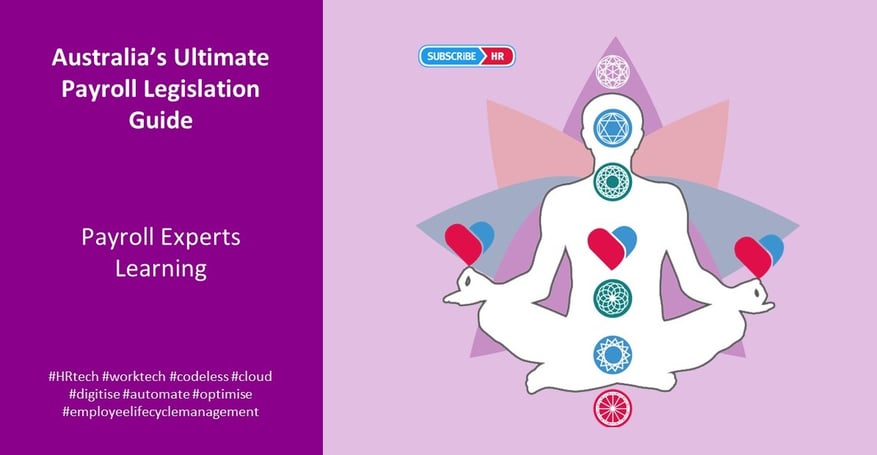As an employer in Australia, few tasks are as crucial as managing payroll. But ensuring your employees receive their rightful wages, entitlements, and benefits while adhering to the ever-evolving web of employment laws can be a daunting challenge. 😣
The Australian payroll system is governed by an extensive array of legislation, including the Fair Work Act, National Employment Standards (NES), Modern Awards, and various state and territory industrial relations systems. Attempting to understand this labyrinth of regulations can leave even the most seasoned business owners feeling overwhelmed and lost.
Join us as we break down the intricacies of the Fair Work System, explore the nuances of the National Employment Standards and Modern Awards, and unravel the intricacies of Registered Agreements and state-specific industrial relations systems ⬇️

Understanding Australia’s Legal Landscape for Payroll
Australia’s National Workplace Relations System (Fair Work System)
In Australia, the management of payroll is governed by a comprehensive framework known as the National Workplace Relations System, commonly referred to as the Fair Work System.
👉 This system plays a crucial role in regulating employment relationships and establishing the rights and obligations of both employers and employees across the nation.
Overview of the Fair Work System
The Fair Work System was established to provide a cohesive and standardised approach to employment relations in Australia. It serves as the foundation for employment laws and policies, aiming to strike a balance between the interests of employers and employees.
At the heart of the Fair Work System is the Fair Work Act, a comprehensive piece of legislation that came into effect in 2009. The Act outlines the fundamental rights and protections of employees, sets minimum standards for employment conditions, and establishes the framework for resolving workplace disputes.
What the Fair Work Act means
The Fair Work Act is the cornerstone of the National Workplace Relations System. It provides a comprehensive legal framework that governs almost every aspect of employment in Australia. It covers a wide range of areas, including minimum wages, working hours, leave entitlements, unfair dismissal protections, and collective bargaining rights.
Why this is important
As an employer, understanding the Fair Work System is not only a legal requirement but also a key element in creating a fair and harmonious workplace. Compliance with the system's regulations ensures that employees are treated fairly, their rights are protected, and their well-being is prioritised.
Familiarity with the Fair Work System also helps businesses avoid costly legal disputes and penalties resulting from non-compliance. Failure to adhere to the Act's provisions can lead to significant financial repercussions, damage to the organisation's reputation, and potential legal action by employees.
National Employment Standards (NES)
Under the Fair Work Act, employers must adhere to the National Employment Standards (NES), which represent the minimum entitlements for most employees. These standards encompass critical aspects of employment, such as maximum weekly working hours, annual leave, parental leave, personal and compassionate leave, and public holidays.
The NES plays a pivotal role in establishing a fair and balanced employment relationship, providing a safety net for workers and ensuring they receive essential rights and benefits in the workplace. ⬇️
Maximum Weekly Hours of Work
The NES sets a limit on the number of hours an employee can be required to work in a standard week. For full-time employees, the standard is 38 hours per week (plus reasonable additional hours). Employers can’t require employees to work excessive hours, as this could lead to issues such as burnout and decreased productivity.

Flexible Working Arrangements
Employees with caring responsibilities, a disability, or who are of a certain age have the right to request flexible working arrangements. This can include changes to their working hours, patterns, or locations. As an employer, you are obligated to seriously consider these requests and only refuse them on reasonable business grounds.
Parental Leave
The NES provides employees with the right to parental leave, allowing them to take time off to care for a newborn or newly adopted child. Eligible employees are entitled to up to 12 months of unpaid parental leave, ensuring they can balance their work and family responsibilities.
Annual Leave
Employees are entitled to a minimum of four weeks of paid annual leave per year, which is accrued progressively based on their length of service. This entitlement allows employees to take time off for rest, relaxation, and personal pursuits.
Personal/Carer's Leave and Compassionate Leave
Employees are entitled to paid personal leave for illness or injury, including carer's leave to care for an immediate family member or household member who is ill or injured. Additionally, compassionate leave is granted for the death or serious illness of an immediate family or household member.
Community Service Leave
Employees are entitled to take unpaid leave for voluntary emergency activities, such as serving as a member of a recognised emergency management body.
Long Service Leave
Long service leave entitlements are not covered under the NES, as they vary across different states and territories. Employers must consult the relevant state or territory legislation to determine long service leave entitlements for their employees.
Public Holidays
The NES recognizes certain public holidays that employees are entitled to take as paid leave. The specific holidays may vary depending on the state or territory where the work is performed.
Notice of Termination and Redundancy Pay
The NES outlines the minimum notice period an employer must provide when terminating an employee's employment. It also sets criteria for redundancy pay based on the employee's length of service.
Fair Work Information Statement
Employers are required to provide new employees with a copy of the Fair Work Information Statement, which outlines their rights and entitlements under the NES. This must be given to employees as soon as possible after they start their employment.
Individual Flexibility Arrangements
While the NES sets out minimum standards, it also allows for flexibility through individual flexibility arrangements (IFAs). These arrangements can be negotiated between employers and individual employees to vary certain NES entitlements, provided the employee is better off overall.

Modern Awards
Modern Awards are industry or occupation-based minimum employment standards that work in conjunction with the NES. These awards play a crucial role in ensuring that employees within specific industries or occupations receive fair and consistent treatment, tailored to the unique requirements of their respective sectors.
How modern awards apply to specific industries and occupations
Modern Awards are designed to cover a wide range of industries and occupations, ensuring that employees within each sector are provided with the minimum standards of pay and conditions relevant to their work.
Different Modern Awards apply to distinct industries or occupational groups, and employers must identify the appropriate award(s) that apply to their workforce. The Fair Work Commission is responsible for creating and updating Modern Awards to reflect changes in industry practices and economic conditions.
🛎️ For instance, a Modern Award may apply to employees in the hospitality industry, healthcare sector, construction field, retail, or any other specific occupation.
Key entitlements covered by modern awards
Modern Awards outline a range of essential entitlements that employers must provide to their employees, including but not limited to 👇
- Base Rates of Pay: The minimum hourly or weekly rates of pay that must be paid to employees for their ordinary hours of work. These rates may vary depending on the employee's classification, experience, and qualifications.
- Hours of Work: Specifications regarding ordinary working hours, overtime, and shift work arrangements, ensuring employees are not overworked and are compensated fairly for any additional hours worked.
- Penalties: Additional pay rates applied for working outside of standard hours, such as weekends, public holidays, or night shifts, to acknowledge the inconvenience or unsociable hours.
- Allowances: Extra payments to compensate employees for specific work-related expenses, such as travel, uniform, or working in hazardous conditions.
- Leave Provisions: Modern Awards specify the minimum amount of annual leave, personal/carer's leave, and other types of leave (e.g., parental leave) to which employees are entitled.
Protection from Unfair Dismissal
Under the Fair Work System, employees in Australia are afforded robust protection against unfair dismissal. The provisions outlined in the Fair Work Act serve to safeguard employees from arbitrary or unjust termination and ensure that their employment rights are upheld.
Criteria for a valid dismissal and unfair dismissal circumstances
A valid dismissal occurs when an employer terminates an employee's employment for a lawful reason and follows proper procedures. Acceptable reasons for dismissal can include misconduct, poor performance, redundancy, or genuine operational requirements.
However, to be considered fair, the dismissal must meet several criteria ⬇️
- Reasonable Grounds: The employer must have a valid reason for dismissing the employee, such as poor performance or misconduct. The reason must be based on genuine and justifiable grounds.
- Procedural Fairness: The dismissal process must adhere to principles of procedural fairness, also known as natural justice. This entails providing the employee with sufficient notice of the impending dismissal, an opportunity to respond to any allegations or issues, and the right to be accompanied by a support person during discussions.
- Non-Discrimination: Employers must not dismiss employees based on discriminatory factors, such as race, gender, age, religion, disability, or any other protected attributes. Dismissing an employee for such reasons would be considered unfair and unlawful.
- Genuine Redundancy: Redundancy dismissals are valid when a position is no longer required due to operational changes, technological advancements, or financial constraints. However, certain procedural requirements must be met to ensure the dismissal is genuine and fair.
If an employee believes their dismissal does not meet these criteria, they have the right to file an unfair dismissal claim with the Fair Work Commission.
Role of the Fair Work Commission in handling unfair dismissal claims
The Fair Work Commission is the independent regulatory body responsible for administering and resolving unfair dismissal claims in Australia. When an employee lodges an unfair dismissal claim, the Commission assesses the circumstances surrounding the dismissal and determines whether it was unfair.
The Fair Work Commission considers various factors during the process, including the validity of the dismissal, the reasons provided by the employer, the employee's response, and whether procedural fairness was observed. The Commission aims to strike a fair balance between protecting employees from unjust treatment and recognizing an employer's legitimate business needs.
Potential remedies available to employees
If the Fair Work Commission finds that a dismissal was unfair, it may order various remedies, including:
- Reinstatement: Reinstating the employee to their former position with continuity of service and benefits.
- Compensation: Awarding monetary compensation to the employee as a form of remedy for the unfair dismissal.
- Compensation Reductions: The Commission may reduce the compensation awarded to an employee if they contributed to their dismissal due to misconduct or other factors.
- Other Measures: In some cases, the Commission may offer alternative remedies, such as a job transfer or retraining, depending on the specific circumstances of the case.
Registered Agreements (Enterprise Agreements)
Registered Agreements, including Enterprise Agreements, are a vital component of Australia's industrial relations system, allowing employers and employees to negotiate and customise employment conditions to suit specific business needs. These agreements provide flexibility while ensuring that employees are not disadvantaged in terms of pay rates and minimum conditions.
Enterprise agreements and other registered agreements
Enterprise Agreements are negotiated agreements between employers and their employees or employee representatives. They apply to specific businesses or groups of businesses and can cover a wide range of employment conditions, such as wages, working hours, leave entitlements, and dispute resolution processes.
Other types of Registered Agreements include Greenfield Agreements (for new enterprises), Multi-Enterprise Agreements (for multiple employers and their employees), and various industry-specific agreements.
Relationship between registered agreements and modern awards
When an Enterprise Agreement or other Registered Agreement is in force, it replaces relevant provisions of any applicable Modern Award. This means that the conditions outlined in the Agreement prevail over the minimum conditions set in the Modern Award.
However, the Agreement must meet certain criteria to ensure that employees are not worse off than they would be under the relevant Modern Award.
For example, if an Enterprise Agreement offers higher pay rates or more favourable working conditions than the Modern Award, the Agreement must pass the Better Off Overall Test (BOOT). The BOOT requires that, overall, employees covered by the Agreement are better off than they would be under the Modern Award.

Ensuring pay rates in registered agreements comply with minimum standards
While businesses have the freedom to negotiate pay rates in Registered Agreements, they must ensure that these rates are not less than the minimum pay rates prescribed in the relevant Modern Award. Failing to meet this requirement can render the Agreement invalid, exposing the employer to potential legal consequences and claims for underpayment.
Navigating the complexities of pay rates and entitlements
Navigating the complexities of pay rates and entitlements requires a thorough understanding of the Fair Work legislation and its interaction with Registered Agreements and Modern Awards. Employers must stay informed about any legislative changes that may affect their agreements and regularly review the terms to ensure ongoing compliance.
Seeking professional advice from HR consultants or legal experts can help in navigating these complexities and avoiding costly mistakes.
Moreover, maintaining open and transparent communication with employees throughout the negotiation and implementation of Registered Agreements fosters trust and ensures that their interests are considered.
Workplaces Governed by State and Territory Industrial Relations Systems
The Fair Work System serves as the national workplace relations framework that applies to the majority of Australian workplaces.
However, there are certain situations and industries where State and Territory Industrial Relations systems govern employment relations instead of the national system.
While the Fair Work System has a broad reach, certain workplaces and industries fall under the jurisdiction of State and Territory Industrial Relations systems. This includes ⬇️
- State Government Employees: Employees working directly for state governments, such as state public servants, are generally covered by the respective State Industrial Relations systems.
- Local Government Employees: Employees working for local councils are usually covered by the relevant State Industrial Relations systems.
- State-Based Businesses: Businesses that operate solely within a specific state or territory and do not have a presence outside its borders are typically governed by the State Industrial Relations system of that jurisdiction.
- Some Industries: Certain industries, such as the police force, public education, and public health sectors, may be governed by State or Territory Industrial Relations systems due to their specific nature and the services they provide.
Australia’s National Minimum Wage: The Full Lowdown
The Role of National Minimum Wage
The national minimum wage serves as a vital safety net for employees, providing a baseline pay rate for those not covered by Modern Awards or Enterprise Agreements. This essential wage floor protects workers from unfair remuneration and exploitation, ensuring they receive a fair income regardless of their industry or occupation.
Special National Wages
Special national wages provide specific wage rates for certain employee categories, such as persons with disabilities, trainees, apprentices, and juniors. These rates ensure fair compensation and equal opportunities for those with unique circumstances.
- Persons with Disabilities: The wage rate for an employee with a disability may be determined based on their productivity or assessed work capacity, ensuring they receive appropriate remuneration in relation to their contribution to the workplace.
- Trainees and Apprentices: The wage rate for trainees and apprentices is usually set as a percentage of the full wage rate for qualified workers. As the trainee or apprentice gains experience and progresses in their training, their wage may increase accordingly.
- Juniors: Juniors are typically entitled to a percentage of the adult wage rate, which is based on their age and may increase gradually as they reach certain age milestones.
Annual Update of National Minimum Wage
The national minimum wage undergoes an annual review process to ensure it remains reflective of current economic and social conditions. During the review, factors like economic indicators, cost of living, and social considerations are carefully examined.
The timeline for implementation is set by the Commission, with any changes typically taking effect on July 1st each year. This annual update ensures that the national minimum wage continues to provide a meaningful safety net for Australian workers.
How to Manage Your Australian Payroll Process
Payroll Preparation
Employee Data Collection
To manage the Australian payroll process effectively, collect essential employee data. This includes employee details, tax file numbers, superannuation fund information, and bank account details. Safeguarding privacy is vital, so ensure data is securely collected and stored in compliance with privacy laws. ✅
Time and Attendance Tracking
Effective time and attendance tracking is crucial for accurate payroll management. Employers can choose from various methods, including manual timecards, time clock systems, or digital time-tracking software, each offering unique benefits and considerations.
To handle variations in working hours, overtime, leave, and other time-related factors, employers must maintain clear records and comply with relevant employment laws. That's why precisely recording employee working hours and managing overtime pay are essential to ensure fair compensation.
Additionally, handling leave requests and tracking accrued leave balances accurately is extremely important for maintaining a well-functioning workforce.
Payroll Schedule Planning
In payroll schedule planning, businesses need to carefully consider the most suitable pay frequency, such as weekly, fortnightly, or monthly, based on their operational requirements and employee preferences.
Adhering to a consistent payroll schedule is paramount to ensure timely and accurate payments, promoting employee satisfaction and financial stability. Regular pay cycles create a sense of reliability and trust among employees, reducing stress and uncertainty. It also helps businesses maintain their financial planning and budgeting. ✅
Payroll Calculation
Gross Pay Calculation
Calculating employees' gross pay requires a comprehensive approach that considers regular hours, overtime, bonuses, and commissions. For hourly employees, multiply their hourly rate by the number of hours worked, accounting for any overtime hours at the appropriate rate.
Salaried employees' gross pay is determined by dividing their annual salary by the number of pay periods. For commission-based employees, the gross pay is the sum of their base salary and any commissions earned during the pay period.
Deductions and Withholdings
Managing deductions and withholdings in payroll requires precision to comply with tax laws and ensure employees' net pay is accurate. This involves deducting income tax based on individual tax rates using tax tables.
Additionally, the compulsory Medicare levy is withheld to fund the public health system. Employers must also handle voluntary deductions like salary sacrifice contributions. Accurate calculations are essential to withhold the correct amounts, avoiding under or over-withholding.

Superannuation Contributions
Calculating and making superannuation contributions is a vital responsibility for employers, ensuring financial security for eligible employees during retirement. Here's our take on how to handle superannuation:
- Superannuation Guarantee Calculation: Employers must contribute a percentage of eligible employees' ordinary time earnings to their superannuation fund. The current superannuation guarantee percentage is determined by legislation and may be subject to periodic changes. Accurate calculations are essential to meet these obligations and secure employees' future financial well-being.
- Employer Obligations: Employers must comply with superannuation laws, which include making regular contributions and ensuring timely payments to employees' chosen superannuation funds. Failure to meet these obligations may result in penalties.
- Choosing a Complying Superannuation Fund: Employers can select a complying superannuation fund for their employees, providing various investment options and features. Considerations should include fees, investment performance, insurance options, and compatibility with the company's payroll system.
Leave Accruals and Entitlements
Managing leave accruals is pivotal for ensuring compliance with employment standards and providing employees with appropriate time-off benefits.
Calculating and managing annual leave, sick leave, and other types of leave entitlements involves adhering to the National Employment Standards and relevant Modern Awards. Employers need to accurately track and update leave balances to ensure employees have access to their entitled leave.
Payroll Distribution
Payment Methods
Choosing the right payment method is essential for seamless and secure payroll distribution. Employers can opt for direct deposit, physical checks, or digital payment platforms, each with its advantages and considerations.
Direct deposit offers convenience, eliminating manual handling and ensuring prompt payments. Physical checks may be preferred by some employees, but they require additional resources and processing time. Digital payment platforms provide real-time access to funds, enhancing employee satisfaction.
Payslip Generation
Creating comprehensive payslips is essential for transparent and efficient payroll management. Payslips should include crucial information such as gross pay, deductions, net pay, superannuation contributions, and leave balances.
Employers must ensure accuracy and compliance with employment laws while generating payslips efficiently. Digital systems can streamline the process, providing secure and timely access to payslips for employees. Efficient distribution methods, whether through email, online portals, or physical copies, contribute to a smooth payslip generation process.
Compliance with Single Touch Payroll (STP)
Meeting Single Touch Payroll (STP) reporting requirements is essential for Australian employers to maintain accurate and timely reporting to the Australian Taxation Office (ATO).
STP enables real-time reporting of payroll information, including salaries, wages, and superannuation contributions, directly to the ATO with each pay cycle.
Employers can achieve compliance through STP-enabled payroll software, simplifying the reporting process and reducing administrative burdens. STP software ensures seamless data transmission, eliminates the need for separate reporting submissions, and enhances data accuracy. ✅

Common Payroll Challenges and Solutions
Payroll Compliance
Identifying and addressing common payroll compliance issues is crucial for businesses to avoid potential legal and financial repercussions. Common challenges include underpayment, incorrect employee classification, and non-compliance with legislative requirements.
To ensure payroll compliance, businesses should implement robust strategies, such as conducting regular payroll audits, staying updated on employment laws, and utilising reliable payroll software. Proper record-keeping and documentation are essential to demonstrate compliance in case of audits.
Managing Employee Leave and Absences
Effectively handling employee leave and absences is vital to ensure accurate payroll management and minimise disruptions in the workplace. Employers can implement strategies such as clear leave policies, timely leave requests, and effective communication to prevent payroll inaccuracies.
Leave tracking software plays a crucial role in streamlining the process by automating leave requests, approvals, and tracking accrued balances. This technology ensures transparency, reduces administrative burdens and allows for better resource planning.
Dealing with Payroll Errors
Promptly identifying and rectifying payroll errors is essential for maintaining employee trust and satisfaction. Employers must review payroll reports regularly to spot discrepancies in wages, deductions, or leave balances. In case of errors, immediate action is crucial to correct the issues and ensure employees receive accurate payments.
To prevent errors, implementing best practices such as double-checking data, conducting payroll audits, and providing training to payroll administrators is essential. Transparent communication with employees regarding error resolution reinforces trust and demonstrates a commitment to fair and accurate payroll practices, fostering a positive work environment and employee confidence. ✨
Final Thoughts

From data preparation to distribution, adhering to employment laws and best practices is central to fostering employee satisfaction and upholding legal requirements. It is essential to stay updated on evolving payroll laws and seek professional advice for complex challenges.
When employers prioritise these principles, they are able to build a robust payroll system that ensures fair compensation and employee well-being. Ultimately, a well-managed payroll process enhances organisational integrity, promotes employee trust, and contributes to a successful and harmonious work environment. ✅

